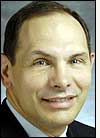At the RFID Journal LIVE! 2008 conference, held this week in Las Vegas, Gregory L. Johnston, Sam’s Club‘s executive VP of club operations, reaffirmed his company’s belief that both the retailer and its suppliers will profit from the technology’s implementation. In the retail market, Johnston told conference attendees on Wednesday, the evolutionary path of RFID technology and the Electronic Product Code (EPC) is comparable to that of the bar code and the Universal Product Code (UPC) in the 1970s. “Just like UPC,” he said, “EPC can help all of us improve the services we provide.”
As of Jan. 31, 2008, Sam’s Club, owned and operated by Wal-Mart, began requiring all of its suppliers to apply EPC Gen 2 RFID tags to every full single-item pallet of goods destined for its distribution center in DeSoto, Texas, or directly to one of its stores served by that DC. Any supplier failing to comply will be charged a service fee, the retailer announced, starting at $2 per untagged pallet on Feb. 1, and capping at $3 per pallet on Jan. 1, 2009. The fee will cover Sam’s Club’s cost in having to tag the pallets itself (see Sam’s Club Tells Suppliers to Tag or Pay).
Johnston told the audience that Sam’s Club believes its RFID mandate plans are reasonable, but also acknowledged and thanked the retailer’s many suppliers in attendance. “We ask a lot of our suppliers, and you deliver a lot,” he said, adding that RFID “will bring a benefit to all of us.”
By Jan. 30, 2009, Sam’s Club intends to have suppliers tag full single-item pallets destined for all 22 of its distribution centers. The suppliers must also tag at the item level for shipments to all 22 DCs by Oct. 31, 2010. Because Sam’s Club is a warehouse retailer, items are typically bulk goods packaged in large units. Johnston predicted tagging will lead to increased sales resulting from fewer out-of-stocks, better product placement, fewer out-of-date products, faster checkout and better-quality products (due, for instance, to fresher produce). These features, he added, would benefit the entire CPG industry.
More than 3,000 people had preregistered to attend LIVE!, with more than 175 providers of RFID hardware, software and services filling the event’s 100,000-square-foot exhibit hall to capacity (see Exhibit Hall at RFID Journal LIVE! 2008 Is Sold Out). Among the other speakers at the event was Bob McDonald, chief operating officer of Procter & Gamble. Like Johnston, McDonald referenced the history and evolution of RFID technology in the supply chain during a keynote presentation on Thursday. He charted for attendees the early research into RFID that engineering teams at both P&G and Gillette—which P&G purchased in 2005—initiated, as early adopters and as members of the Auto-ID Center, which developed the Electronic Product Code (EPC) concept.
McDonald also stressed the importance of retailers and suppliers working together closely to extract what he called shared value creation from RFID. He presented a scorecard for EPC adoption in the retail industry to date, grading standards development with an A-minus, but retailer engagement and shared value creation both earned Cs. According to McDonald, only two major retailers have initiated significant pilot projects to determine the value of using RFID to track product promotions, which he said represents tremendous potential for improved sales and efficiencies.
In addition, Microsoft announced at the conference that it has entered into beta testing on a version of its BizTalk RFID middleware designed to run on mobile RFID readers. Anush Kumar, Microsoft’s senior product director, joined with two Microsoft partner companies, RFID solutions providers Xterprise and S3Edge, to describe the process of testing the beta software with customers.
“We are currently testing the beta version of the software with some private customers,” says Steve Sloan, lead product manager for Microsoft’s Connected Systems division, “and then we will conduct public beta testing, and we are aiming to have the software generally available by the fourth quarter of this year.”
On the hardware side, Ray Martino, Motorola‘s chief technology officer, told attendees he sees mobility as the future of RFID. The growth in the mobile market, he explained, will help fuel RFID growth.
The marker for this growth, Martino said, is the cell phone market, in which 1.2 billion mobile phones were sold worldwide last year. Given their built-in processing power, he added, today’s cell phones rival the functionality of computers. Consumers can expect their phones to be the RFID interrogators of the future—reducing waits at retail locations, as well as linking them to stores in other ways, such as downloading coupons for price reductions at the point of sale.
Stores will soon have other smart mobile devices as well, Martino said, including RFID-enabled mirrors, tables and kiosks, to be used with mobile phones to provide data about products. “RFID is no longer a matter of a portal in the backroom. You can expect to see RFID in the front of the store,” he said, and to “change the shopping experience.”
Martino advised that RFID users consider not only technology they think will be a “good fit” for their application, but also how the technology can be expected to perform in the future. “The best fit may not always be the best choice,” he noted. “How many vendors are driving it, for example? Where is the world going with that technology?”
RFID has crossed the chasm, Martino said, and the question of “Will it work? or When will it work?” no longer needs to be asked. “It works,” he stated.
Indeed, this was the sentiment shared by many speakers and attendees at the conference. Whereas past discussions revolved around how to make RFID technology work to meet customer needs, those at the event indicated, current discussions are about extracting business value from those applications.





